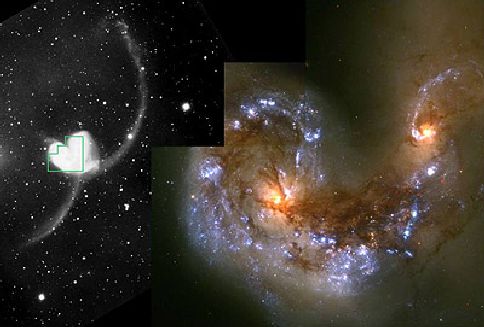Explanation: A ground-based telescopic view (left) of the collision between the galaxies NGC4038 and NGC4039 reveals long arcing insect-like "antennae" of luminous matter flung from the scene of the accident. Investigators using the Hubble Space Telescope to sift through the cosmic wreckage near the two galaxy cores have recently announced the discovery of over a thousand bright young clusters of stars - the result of a burst of star formation triggered by the collision. The green outline shows the area covered by the higher resolution Hubble image (right). At the distance of the Antennae galaxies (about 63 million light-years), a pixel in this image corresponds to about 15 light-years. Dust clouds around the two galactic nuclei give them a dimmed and reddened appearance while the massive, hot, young stars of the newly formed clusters are blue. How do colliding galaxies evolve with time? Determining the ages of star clusters formed in galaxy collisions can provide significant clues. The Antennae galaxies are seen in the southerly constellation Corvus.
Tomorrow's picture: Echoes Of A Supernova
1999 2000 2001 2002 2003 2004 2005 2006 2007 2008 2009 2010 2011 2012 2013 2014 2015 2016 2017 2018 2019 2020 2021 2022 2023 2024 2025 |
Январь Февраль Март Апрель Май Июнь Июль Август Сентябрь Октябрь Ноябрь Декабрь |
NASA Web Site Statements, Warnings, and Disclaimers
NASA Official: Jay Norris. Specific rights apply.
A service of: LHEA at NASA / GSFC
& Michigan Tech. U.
|
Публикации с ключевыми словами:
star cluster - colliding galaxies - взаимодействующие галактики - вспышка звездообразования - звездное скопление
Публикации со словами: star cluster - colliding galaxies - взаимодействующие галактики - вспышка звездообразования - звездное скопление | |
См. также:
Все публикации на ту же тему >> | |
